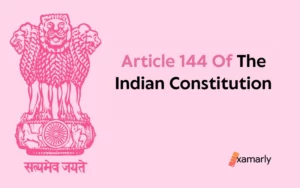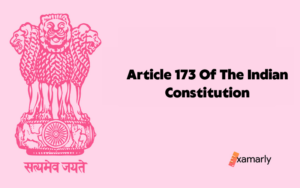In the year 1949, Article 55 was added to the Indian Constitution. This article focuses primarily on how the President was chosen. Every individual who is elected by the legislative assembly of a State of India shall have “votes” as per “multiples of 1000. And the remainder is not less than five hundred” in the quotient that has been determined by dividing the state population by the number of elected members of the Legislative Assembly. This provision of the Indian Constitution also illustrates that it is necessary to maintain consistency in the scale while electing the President across India’s many states.
What Is Article 55 Of The Indian Constitution?
The process for electing the president is described as a provision of Article 55 of the Indian Constitution.
- As much as is practical, the scale of representation of the several States in the presidential election should be uniform.
- In order to ensure equality between the States themselves and between the States collectively and the Union, the number of votes that each selected component of Parliament and of the Legislative Assembly of each State is permitted to cast at such election shall be set in the following manner:
- (a)Each selected partner of a State’s Legislative Assembly is entitled to the same numeral of polls as there are multiples of 1,000 in the quotient created by dividing the State’s population by the complete numeral of elected Assembly members;
- (b) the vote per associate mentioned in clause (a) will be increased by one if, after dividing by the aforementioned multiples of 1,000, the remaining amount is not smaller than 500;
- (c) Each elected partner of either House of Parliament shall be granted the maximum number of votes that can be determined by splitting the entire number of votes allotted to members of the Legislative Assemblies of the States under clauses (a) and (b) by the complete numeral of selected partners of both Houses of Parliament, with fractions greater than one-half being trusted as one and other parts being disregarded.
- A single transferable vote will be used to select the president, and voting will take place in a secret ballot process. It will be in accordance with the commensurate declaration system.
The population in this article refers to that determined by the most recent census, the results of which have been made public:
With the caveat that until the appropriate formations for the foremost census taken after the year 2000 have been published. A reference to the most recent census for which appropriate formations have been broadcasted in this explanation will be interpreted as referring to the 1971 census.
What Are The Qualifications Of The President?
The qualifications for election of President require that an applicant for the position of President must be an Indian national. To be eligible for election as a Lok Sabha member, he or she must be at least 35 years old. The selection of the President is not open to anyone who currently holds a position of profit under the control of the Government of India, the Government of any State, or any other authority.
Value Of Vote Of MP And MLA In President Election In India
Depending on the size of their legislative body, each MP and MLA’s vote has a different weight. Additionally, every elector casts a unique number of votes. The basic rule is that the absolute numeral of votes launched by state legislators and members of parliament must equal one another. More votes are cast by lawmakers from bigger states than from smaller states. The votes cast for each partner of Parliament are calculated by dividing the absolute numeral of votes cast by all the States by the number of selected associates of Parliament (Lok Sabha 543 + Rajya Sabha 233).
Single Vote System
The one-vote, transferrable system. The single transferable vote procedure is used to select the President and constituents of the Rajya Sabha. In order to ensure more diverse representation, the single transferable vote procedure eliminates the possibility of voting blocs dominating minorities. Every candidate running for office is listed on the ballot, and the voters rank them according to their preferences. Candidates must obtain a minimum threshold of votes, or “quota,” in order to be selected.
The quota is established at one more than half the absolute numeral of votes in presidential elections to guarantee that the candidate with a clear majority wins. The quota for the Rajya Sabha is established at the highest numeral of votes that may be obtained by only as many MPs as are necessary to fill all the seats. Until the correct number of candidates have been elected, votes that are deemed surplus, those given to candidates who have already received their full quota of votes, or votes given to candidates who are deemed to be losing candidates are transferred in accordance with the voter’s listed preferences.
Reasons For Indirect Elections
The President only serves as the nominal executive in India’s Parliamentary Democracy system; the Council of Ministers, which is actually the executive and is led by the Prime Minister, holds the real power. The President is chosen through an indirect process because our founding fathers did not think it was necessary to spend a significant amount of time, money, or other resources on a direct election of the nominal executive.
For Further Reading:
Conclusion
Article 55 of the Indian Constitution is contained in Chapter 1 of Part V of the Constitution.
FAQs
In Which Condition Post Of The President Falls Vacant?
Under the subsequent circumstances, the office of the President becomes vacant:
(i) In the event of a President’s death, the position becomes vacant. Within six months, aspects of elections for the new president must be held.
(ii) If a President resigns from his post, his office falls vacant.
Who Elects The Indian President?
According to the Election Commission of India, the President is chosen by the electoral college The electoral college for election of the President includes elected representatives from the Lok Sabha (House of the People), the Rajya Sabha (Council of States), the Legislative Assemblies of the States, and the Union Territories of Delhi and Puducherry.
What Is The Term Of The President’s Office In India?
The President’s term of office begins on the day he assumes office and lasts for five years. But until his successor assumes office, he will continue to serve in that capacity despite the end of his term.
What Is Secret Ballot?
A voter discreetly casts their vote in an enclosure so that no one else may see what they have decided. It’s guided to as a secret ballot. A single transferable vote is used to elect the president using the proportional representation system, and voting is done secretly.
Who Is The President Of India?
The Indian president serves as both the Republic of India’s head of state and the Supreme Commander of its armed forces. Since July 25, 2022, Droupadi Murmu, an Indian politician, has presided as India’s 15th president.
Article 55 Of The Indian Constitution Deals With What?
Article 55 deals with the manner of election of the President of India.






